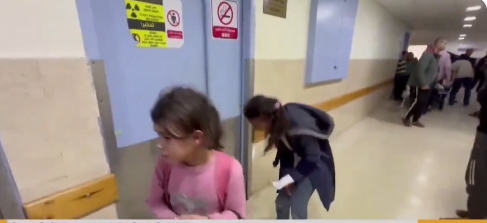As the war continues, Hamas will still steal all aid money and food supplies, and have. They then sell and barter with the hungry people in between their fake press videos that are all stages. The UN, which detests Israel, takes their sides in all matters. Keep that in mind.
A newly released report from the Integrated Food Security Phase Classification (IPC) has highlighted the severe food crisis engulfing Gaza, where almost the entire population faces food scarcity and half a million people are teetering on the edge of starvation. The report reveals that over 340,000 residents are suffering from extreme acute food insecurity, a situation verging on catastrophe—a classification just steps away from famine. This number is expected to surge to nearly half a million within the next quarter.
RISK OF FAMINE IN GAZA – MANY GO MULTIPLE DAYS WITHOUT EATING pic.twitter.com/XHijBoziu0
— Filipe Neves 🇵🇹 🇵🇸 (@_FilipeNeves) June 25, 2024
The IPC, established twenty years ago to address famine in Somalia, compiled this analysis through a combination of publicly accessible data and phone surveys. Their findings indicate that many families in Gaza are driven to barter clothing and other possessions for food, while a significant portion scavenges for sellable materials in rubbish. The dire conditions have forced numerous individuals to endure days without food.
The siege imposed by Israel following attacks by Hamas on October 7, which resulted in significant casualties and hostage situations, has seen a marked increase in hardship. The extensive military responses have led to substantial Palestinian casualties and further exacerbated the humanitarian crisis. Although Israel asserts that it has not explicitly restricted humanitarian aid, reports suggest that limitations on what enters the region continue, impacting the availability of essentials like food, medicine, and fuel.
The new IPC projections have been released.
I placed the prior projection side by side with the current one to see the difference.
Notable changes:
– While the report notes there is still a risk of famine across the Gaza strip, all projections of famine with “reasonable… pic.twitter.com/RfrLDBUgHT
— Avi Bitterman, MD (@AviBittMD) June 25, 2024
Some international pressure, notably from the Biden administration, has prompted incremental improvements, including the opening of a land crossing to allow more aid into northern Gaza. Despite these efforts, aid distribution remains sporadic, with southern and central Gaza particularly hard-hit following recent escalations in conflict. The IPC’s latest findings indicate a persistent and possibly increasing risk of famine throughout the region, underlining a scenario of ongoing extreme human suffering.
Further complicating the situation, accusations have been levied against Israel for using starvation as a tactic of warfare, a claim that Israeli officials vehemently deny. Nonetheless, humanitarian organizations continue to report difficulties in distributing aid due to ongoing conflict and logistical challenges. Aid workers have faced lethal threats, and aid delivery has been obstructed by looting and targeted attacks, highlighting the lawlessness and desperation pervading the area.
Food security experts warns that over 20% households in #Gaza go entire days without eating. The latest UN-partnered Integrated Food Security Phase Classification reports Gaza remains at high risk of famine. Over 495,000 people are facing catastrophic levels of food insecurity. pic.twitter.com/R5JzZkKwIV
— CGTN Global Watch (@GlobalWatchCGTN) June 26, 2024
On the ground, organizations like Mercy Corps stress the grim reality faced by Gaza’s residents, who resort to boiling weeds and consuming animal feed to survive. The lack of fresh food, clean water, and medical supplies has left the population in dire straits, with hospitals and other critical infrastructure operating on the brink due to insufficient fuel and supplies.
Healthcare professionals in Gaza City, like Dr. Osama Hamed from Project Hope, report alarming levels of malnutrition and inadequate medical resources to treat even basic injuries. Cases of severe malnutrition are commonplace, with children especially affected, underscoring the profound impact of the conflict on the youngest and most vulnerable.
Major Points
- Nearly all of Gaza’s population faces significant food shortages, with half a million people at risk of starvation according to a report by the Integrated Food Security Phase Classification (IPC).
- Over 340,000 individuals in Gaza are experiencing extreme acute food insecurity, classified as a “catastrophe,” which is just short of famine conditions.
- Following the Hamas-led attacks on October 7, Israel imposed a siege, leading to restricted entry of essentials such as food and medical supplies, intensifying the humanitarian crisis.
- International pressure has led to some opening of borders for aid, but distribution remains hindered by conflict and logistical challenges, with southern and central Gaza most affected.
- The ongoing conflict and restrictions have resulted in widespread malnutrition, with residents resorting to desperate measures such as eating animal feed and limited medical care exacerbating the health crisis.
TL Holcomb – Reprinted with permission of Whatfinger News



